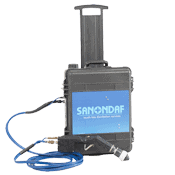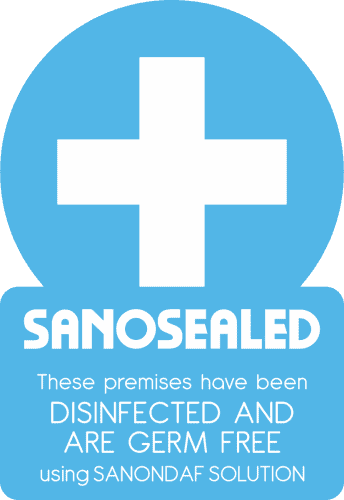Sanondaf touchless cleaning uses state of the art technology to create a spray or fog which reaches every single surface, and even the air of any room. Our patented SanoChem solution kills 99.99% of all bacteria and viruses yet is harmless to humans, animals and plants.
When deployed, SanoChem clings to everything it touches, be it surface or germ. It disinfects surfaces and provides preventative disinfection against future bacteria, viruses and germs, while simultaneously adhering to them and causing them to destroy themselves.
The combination of SanoChem and our market-leading SanoFog and SanoStatic devices mean Sanondaf can have any room cleaner than traditional cleaning techniques, and much more quickly too. Any space, up to a size of 20,000 metres cubed, can be treated in a few minutes using only a single application, and the very nature of disinfectant spray or fog technologies mean it also reaches spots other cleaning techniques cannot.
Our combination of disinfectant liquids and innovative hardware makes Sanondaf’s cleaning and disinfecting services more cost-effective than other disinfecting methods, disinfecting spaces quickly and safely, and even eliminate any odours effectively.
Our SanoFog and SanoStatic technologies transform medical-grade disinfectant liquid into ionized particles. Precision engineered for spectacular results, you’ll be amazed at how quickly and efficiently these devices can clean and disinfect every surface, no matter how hard to reach they may be using traditional or manual cleaning methods.
 SanoFog – Fogging Disinfection
SanoFog – Fogging Disinfection
Our medical-grade fogging equipment features an ionising and heating turbine that converts a high-grade disinfectant liquid into a dry ‘fog’ which fills any room and enters every nook and cranny, achieving a level of disinfection that traditional disinfecting simply cannot match. Our SanoFog technology ensures complete coverage, minimising the risks of cross-contamination associated with manual cleaning techniques. It’s also perfectly safe to use around electrical equipment and devices.
 SanoStatic – Surface Disinfection
SanoStatic – Surface Disinfection
This nifty piece of kit is an electrostatic disinfectant spray system. The spray nozzle jets out a fine spray of disinfecting solution while the specially designed nozzle adds an electrostatic charge to the spray. This helps the disinfectant spray to be attracted to surfaces and helps it to cling to any surface it encounters, ensuring unrivalled disinfection.
What is it?
SanoChem is our proprietary mix of silver and hydrogen peroxide. It can be used as a spray or fog, as well as in water-based solutions, so can be used anywhere.
Is it safe?
Absolutely. SanoChem is safe to use around humans, animals, plants and electrical equipment.
Is it environmentally friendly?
SanoChem is comprised entirely of fully biodegradable chemicals which, in turn, convert into just oxygen and water and does not leave any nasty by-products.
Is SanoChem better than other disinfectants?
Yes, SanoChem has been proven to kill 99.99% of bacteria, viruses and germs. Not only is our SanoChem solution a market-leading disinfectant, our patented SanoFog and SanoStatic technologies also ensure it reaches places other cleaning methods cannot.
What else does SanoChem kill?
As well as bacteria, viruses and germs, SanoChem destroys a variety of different flu viruses and even mould, including the most common type – black mould. SanoChem also leaves an invisible layer of silver ions on all surfaces, helping to protect against future contamination and keeping your space cleaner for longer.
Where can SanoChem be used?
Given that SanoChem is safe for humans, animals, plants and electrical equipment, there is nowhere it cannot be used. If you need a space clean and disinfected, Sanondaf can help you do it quickly and more effectively than any other cleaning system.
Prevention
Cleaning and disinfection have never been more important. The global Covid-19 pandemic has brought a new level of interest and understanding of the dangers of microscopic bacteria, germs and viruses can bring.
Efficiency
There is no cleaning or disinfecting technique that is more effective at killing and providing future protection against bacteria and viruses. 100% environmentally safe and harmless to humans, animals, plants and electrical equipment, Sanondaf and our SanoChem, SanoFog and SanoStatic solutions and devices provide the best possible way of keeping you, your staff and your customers safe. SanoChem has been proven to destroy over 280 known pathogens and counting.
Cost-Efficiency
Sanondaf’s touchless disinfection devices can be used by a single technician, the treatments can be completed in minutes and are more effective than any other technique.


 SanoFog – Fogging Disinfection
SanoFog – Fogging Disinfection

